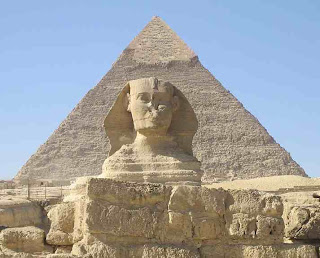.jpg)
For One hundred years after the fall of the Old Kingdom, Egypt was divided into dozens of independent states. Egypt was then reunited by Mentuhotep II. The reuniting of Egypt marked the beginning of the Middle Kingdom. The Middle Kingdom lasted from 2040-1552 B.C. The Middle Kingdom consisted of four dynasties.
The eleventh dynasty was the first dynasty of the Middle Kingdom. The eleventh dynasty ruled from 2133-1991 (140 years). It consisted of seven rulers. Many great things were accomplished in the eleventh dynasty. Heracleops was defeated, Egypt was reunited, and trade with the Red Sea, via the Wadi Hammamat, was resumed.
The twelfth dynasty ruled from 1985-1773 (212 years). It consisted of 8 rulers. The twelfth dynasty represented the cultural and political apex of the Middle Kingdom. During this dynasty Memphis was made the capital of Egypt. Kings of this dynasty also built pyramids. These pyramids were poor in quality, but respectable in size.
The thirteenth dynasty ruled from 1773-1650 B.C. (113 years). The number of rulers in the thirteenth dynasty is unknown. The shift from the twelfth dynasty to the thirteenth dynasty was very undramatic. During this dynasty Egypt had power over Lower Nubia. This dynasty came to an end by military defeat to the Hyksos.
The fourteenth dynasty ruled from about 1786-1603 B.C. This dynasty represents the last period and decline of the Middle Kingdom.
"These kings appear to have gradually lost their grasp over Egypt. A Fourteenth Dynasty appeared in the Delta region, but the pharaohs of this dynasty seem to have been minor monarchs in the Delta region."(source)
The eleventh dynasty was the first dynasty of the Middle Kingdom. The eleventh dynasty ruled from 2133-1991 (140 years). It consisted of seven rulers. Many great things were accomplished in the eleventh dynasty. Heracleops was defeated, Egypt was reunited, and trade with the Red Sea, via the Wadi Hammamat, was resumed.
The twelfth dynasty ruled from 1985-1773 (212 years). It consisted of 8 rulers. The twelfth dynasty represented the cultural and political apex of the Middle Kingdom. During this dynasty Memphis was made the capital of Egypt. Kings of this dynasty also built pyramids. These pyramids were poor in quality, but respectable in size.
The thirteenth dynasty ruled from 1773-1650 B.C. (113 years). The number of rulers in the thirteenth dynasty is unknown. The shift from the twelfth dynasty to the thirteenth dynasty was very undramatic. During this dynasty Egypt had power over Lower Nubia. This dynasty came to an end by military defeat to the Hyksos.
The fourteenth dynasty ruled from about 1786-1603 B.C. This dynasty represents the last period and decline of the Middle Kingdom.
"These kings appear to have gradually lost their grasp over Egypt. A Fourteenth Dynasty appeared in the Delta region, but the pharaohs of this dynasty seem to have been minor monarchs in the Delta region."(source)
Lassieur, Allison. The Ancient Egyptians. San Diego, Ca: Lucent Books, 2001.
Romer, John. People of the Nile. New York: Crown Publishers, 1982.



